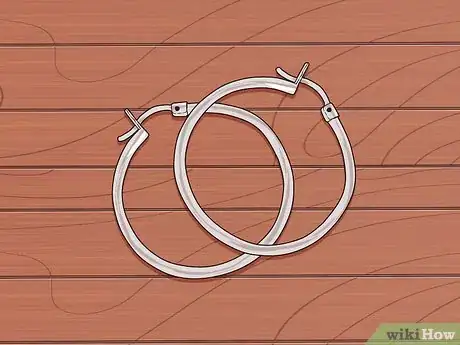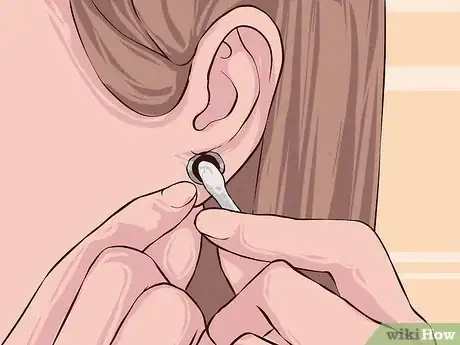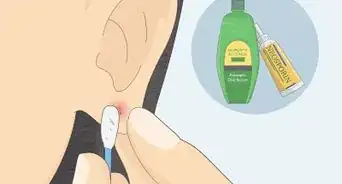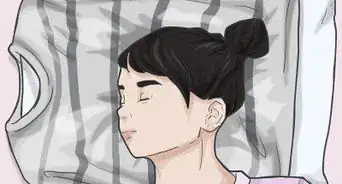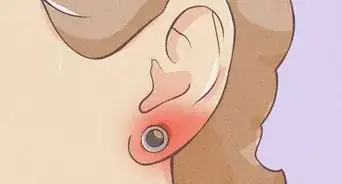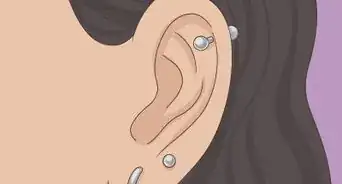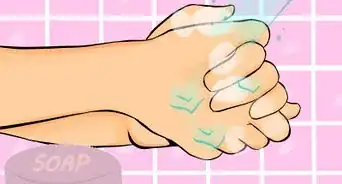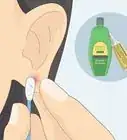This article was co-authored by Stephanie Anders. Stephanie Anders is the Owner and Head Piercer at Royal Heritage Tattoo and Piercing, a tattoo and piercing studio located in Los Angeles, California. Stephanie has over 10 years of piercing experience and her client list includes such stars as Jennifer Aniston, Jessica Alba, Cameron Diaz, Nicole Richie, Gwyneth Paltrow, and Sharon Osbourne.
wikiHow marks an article as reader-approved once it receives enough positive feedback. In this case, several readers have written to tell us that this article was helpful to them, earning it our reader-approved status.
This article has been viewed 383,486 times.
Getting your ears pierced is an exciting experience, and so is picking your first pair of earrings! There are a few factors to consider when choosing your earrings, including figuring out the style you like, deciding which type of metal to get, and picking a place to get your ears pierced. If you're unsure of what kind of earrings to get, you can always ask a professional piercer for advice.
Steps
Choosing the Right Earrings
-
1Get your earrings in the proper metal. Surgical stainless steel earrings are typically your best bet for new piercings, as this metal is the least likely to cause an allergic reaction. Nickel and cobalt allergies are very common, so avoid these metals when you first get your ears pierced. When you get your ears pierced, ask the piercer to help you pick out earrings so that you get the right metal.
- Besides surgical stainless steel, other fairly safe options include platinum, titanium, and 14K gold.
- Talk to your doctor if you want to determine if you have metal allergies.[1]
-
2Pick small rings/hoops for easy cleaning and healing. These small hoops and rings are usually made of stainless steel and are the ideal type of starter jewelry for a lobe piercing. Since slight swelling may occur after you get your ears pierced, getting hoops or rings won’t put any pressure on your healing piercing like studs sometimes can.
- There are 2 common types of rings/hoops:
- Ball closure rings are squeezed together around a ball to stay in place. The ball has a tiny indent on each side for the ends of the ring to fit into. The pressure of the ring keeps the ball in place.[2]
- Spring closure earrings are hoops/rings that open and close with a spring that snaps in and out of place. Open the spring to place the earring on your ear, and once the earring is on, close the spring. This creates a solid hoop/ring.
- Hoop and ring piercings are typically easier to clean because they don't have earring backs that block your fresh piercing.
- Make sure to get hoops or rings that are snug on your ear lobe, you won't want your piercing to move too much.[3]
Advertisement - There are 2 common types of rings/hoops:
-
3Choose studs for your ear piercings. Studs are the most popular type of earrings for new piercings because they are small and cute. Many people prefer studs because they don't get in the way and they go with everything. Studs are fairly easy to clean but tend to get infected more easily than hoops. This is because they have earring backs than can be tricky to clean.[4]
- If you choose studs, make sure to take extra care when cleaning your piercings.
- Most piercing stores like Claire's or Icing use specialty studs when they pierce ears. These studs usually have a sharp, pointed tip to make a clean piercing, as well as a "safety" clutch earring back that limits the risk of pushing the back too tightly against the fresh piercing.
- If you are going to a store to get your ears pierced, pick an earring that doesn't catch on clothes, such as ones with rhinestones because they need prongs to hold them in. Also, avoid overly large studs, as this will make your piercing more troublesome to clean.
-
4Pick the right earrings for you. Since you'll have to wear these earrings for at least 6 weeks before changing them, make sure you pick a pair of earrings that you like. Picking a pair of simple hoops or studs is ideal, as they'll go with everything.
- Make sure to get lightweight earrings when you get your ears pierced. Heavy earrings could damage your new piercings, take longer to heal, and cause you pain.
EXPERT TIPYlva Bosemark is a high school entrepreneur and the founder of White Dune Studio, a small company that specializes in laser cut jewelry. As a young adult herself, she is passionate about inspiring other young adults to turn their passions into business ventures.Jewelry Maker & Entrepreneur
 Ylva Bosemark
Ylva Bosemark
Jewelry Maker & EntrepreneurConsider buying from an independent jewelry designer. Ylva Bosemark, a teenage entrepreneur and jewelry designer, says: "It's important to try to understand where the jewelry comes from and how it was made. If you're supporting a local business or an artist who makes jewelry and has a story, I think that's important to consider when you're choosing what you're wearing."
Going to a Professional Piercer
-
1Go to a professional piercing studio. It's best to get all of your piercings done at a reputable, high-quality piercing studio. Often, piercing shops are combined with tattoo shops, but don't let that scare you. The piercers in these shops are always properly licensed and have a great deal of experience. Also, the sterilization process at these shops is much more strict than at any other piercing locations.
- These piercers give piercings with sterilized needles and usually use small rings/hoops.
- Even if a young child wants to get their ears pierced, you can take them to a tattoo/piercing shop.
- These shops usually have a jewelry selection for you to choose from. They can help you choose the right earrings if you're unsure of what to get.[5]
-
2Visit ear-piercing stores, such as Icing or Claire's. These stores have a huge variety of earrings to choose from and usually offer free piercing with the purchase of a pair of earrings. Most of the jewelry in stores such as these tends to be lower quality, so ask for assistance in finding higher quality jewelry for your piercing.
- These stores do piercings with piercing guns and usually pierce with studs.
- These stores and kiosks are usually found in malls and shopping centers.
-
3Consider getting ear piercings at a medical clinic. Medical Ear Piercing clinics are usually picked by parents when they're looking to get their children's ears pierced. The staff at these places are always professionally trained and the piercing is done in a completely sterile environment.
- There are a few Medical Ear Piercing clinics around the country, but these clinics are far less popular than piercing shops or piercing stores.
- You must book an appointment to get your ears pierced at one of these clinics.[6]
- Other doctor's offices and walk-in clinics sometimes do piercings as well.
Taking Care of Your Piercing
-
1Make sure that the earrings are sterilized prior to putting them in your ears. All professional piercing locations should have properly sterilized earrings and piercing equipment, and most new earrings will come in sterilized packaging. If you decide to bring your own earrings to the piercer, soaking them in rubbing alcohol is a great way to sterilize them.
-
2Clean your piercings regularly. It is important that you clean your new ear piercings 2-3 times per day. After each cleaning, you should turn the earrings one full rotation to avoid any scabs or infection. Make sure to wash your hands with antibacterial soap prior to cleaning your ears.
- Some choose to clean their piercings with rubbing alcohol and hydrogen peroxide. These are good options, but they do tend to sting.
- Some recommend cleaning your new piercings with salt water. This is a more natural method, but is just as effective.
- Some piercing stores give out an after-care solution for you to clean your ears with.[7]
- Apply your cleaning solution of choice with cotton swabs or cotton balls. Gently rub your cotton ball or cotton swab on the front and back of your piercing.
-
3Leave the piercings in for at least 6 weeks. It is important that you do not take your earrings out for a minimum of 6 weeks for lobe piercings and 12 weeks for cartilage piercings. If you take your earrings out, your ears are likely to close or possibly get an infection.
- For the first 6 months after your piercing, try to leave earrings in at all times. Fresh piercings can close very quickly, so it's best to leave in your earrings to allow your piercings to completely heal.
-
4Don't change your piercing. It's common to be anxious to change your earrings but resist the urge. Keep in your basic hoops or studs until your piercing has completely healed. If you change your earrings too soon, you risk damaging or infecting your piercings.
-
5Watch for signs of infection. Piercings are prone to infections if they aren't properly cleaned, which is why you must take extreme care when cleaning your piercings. If you notice signs of infection, visit your doctor.
- Some signs that your piercing has become infected include:
- Tenderness around your piercing after the first 48 hours.
- Swelling around the piercing more than 48 hours after a new piercing.
- Bleeding from your piercing.
- Puss discharge from the piercing.
- Being unable to rotate your earrings when cleaning them.
- Fever, especially in children. If you have a fever, it's important to get to a hospital right away, as you may have a serious infection.
- Some signs that your piercing has become infected include:
Community Q&A
-
QuestionHow do I rotate hoop earrings?
 Community AnswerYou don't. Some piercers recommend you never touch the piercing unless you're cleaning it, others say to wiggle it periodically. Ask whoever does yours for their opinion.
Community AnswerYou don't. Some piercers recommend you never touch the piercing unless you're cleaning it, others say to wiggle it periodically. Ask whoever does yours for their opinion. -
QuestionHow do I know if an infection is forming?
 Community AnswerYour ear will start to turn red and may swell, itch or become painful.
Community AnswerYour ear will start to turn red and may swell, itch or become painful. -
QuestionHow do I choose the right color gemstone in the middle?
 Community AnswerThere is no right color, just pick which one you like best!
Community AnswerThere is no right color, just pick which one you like best!
References
- ↑ http://www.parents.com/health/ear-infection/ear-piercing-for-kids/
- ↑ http://www.bodyjewelleryshop.com/body_piercing_information/types-of-jewellery/ball-closure-ring-jewellery/
- ↑ https://www.painfulpleasures.com/community/help-center/piercing-information/faqs-about-ear-piercings/#What%E2%80%99s%20the%20best%20type%20of%20starter%20ear%20piercing%20jewelry
- ↑ http://invernesscorp.com/5-things-to-know-before-getting-your-ears-pierced/
- ↑ http://time.com/1410/why-i-took-my-7-year-old-to-a-tattoo-parlor/
- ↑ http://www.medicalearpiercing.com/faqs/#toggle-id-9
- ↑ http://invernesscorp.com/5-things-to-know-before-getting-your-ears-pierced/
About This Article
To pick earrings when you get your ears pierced, choose a pair made of surgical stainless steel, since this metal is the least likely to cause an allergic reaction. Platinum, titanium, and 14K gold are also usually safe metals. Go with a pair of small, simple hoops or studs for easy cleaning and healing. Picking a pair of simple hoops or studs is also ideal because they'll go with everything! For tips on communicating what you want to your piercer, read on!

